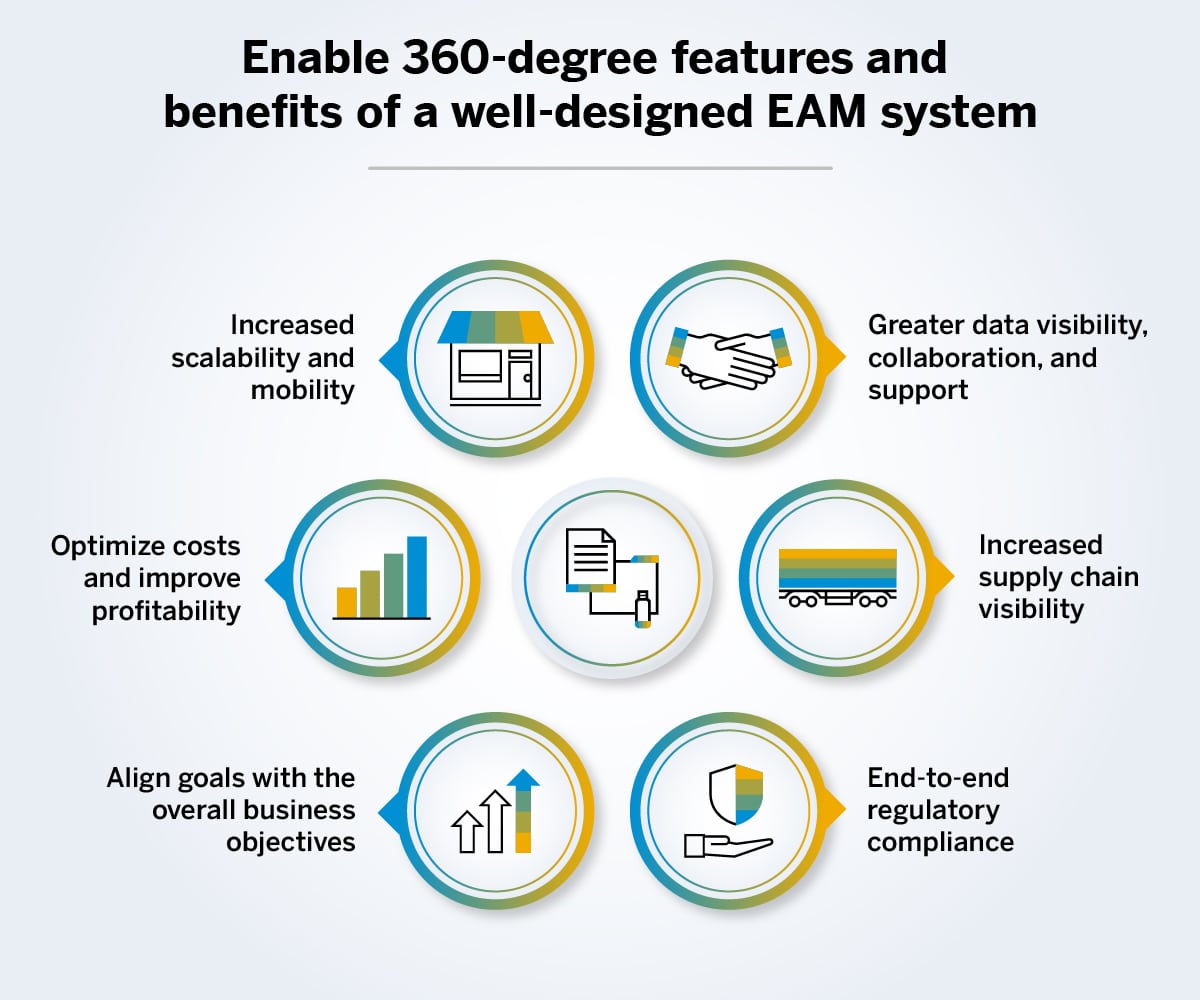With the pandemic, the wave of digital disruption made its way into the healthcare industry. While the scope and speed of change this will bring are still being debated, there is no doubt that transformation is already underway. On the contrary, Enterprise Asset Management (EAM) has transformed the future of business as we know it. Several disruptive forces in the healthcare sector have been pushing this barrier and changing the way care is delivered. Consequently, each cog of the dynamic Life Sciences industry faces mounting pressure from multiple directions.
Delivery expectations have changed across the globe. Consumer demands are evolving on an everyday basis, thus affecting product development. Regulators, on the other hand, are tightening the noose to assure safe and quality products, requiring close supply chain tracking. Startups are providing intense competition to gain a larger piece of the market share. Companies—irrespective of size and scope—are adapting and growing at an unprecedented scale.
Yet, traditional and outdated systems, as well as archaic processes, can cause operational slowdowns and production delays, thus tightening the noose around innovation-led operations.
In the heavily regulated life sciences industry, a dynamic regulatory and commercial climate and increased global competition have motivated organizations to optimize capital asset performance and attempt to minimize operational risk. In such an environment, the need for an Enterprise Asset Management (EAM) system is more important than ever. Asset management software addresses essential concerns directly by allowing executives to better manage assets that have a direct impact on business performance, such as manufacturing equipment, precision instruments, warehouse machinery, and computing equipment. Tools like analytics, for example, can help navigate challenges with greater efficiency, optimization, and accuracy. Understandably, the Life Science Analytics market has grown 16% in just two years between 2019 and 2021, as per research.

How a well-designed EAM System can Mitigate Future Issues?
In the Life Sciences space, it is imperative for businesses to stay on top of data and processes. An Enterprise Asset Management system can help organizations remain in control of their complex businesses. For example, they can:
- Assist with drug and device serialization needs
- Drive visibility and governance across touchpoints in the supply chain
- Ensure stringent quality requirements
These Multi-purpose Tools can do much of the Heavy-lifting by Providing the following 360-degree Features and Benefits:
- Greater Data Visibility, Collaboration, and Support: Whether it is planning projects or managing costs and delivery, an EAM system like the SAP Asset Intelligence Network acts as a ‘single source of truth’ and empowers businesses to access real-time data from a centralized repository. From data and reports to charts and projections, executives can leverage this tool to extract actionable insights and drive a collaborative decision-making process.
- Increased Supply Chain Visibility: One of the biggest advantages of using an EAM tool within the Life Sciences supply chain process is enhanced visibility into products, materials, demand, procurement, and inventory. Users also get access to reports and analytics on all transactions. Managers can track inventory more accurately and build quality products in a timely and cost-effective capacity. Organizations benefit from all-round governance across the supply chain, which can help with faster regulatory approvals.
- End-to-end Regulatory Compliance: To thrive—and lead—with safety, Life Sciences companies need to change gears from retrospection to foresight. A robust EAM system comes with in-built regulatory compliance and quality control functionalities to ensure that businesses are always regulatory-compliant. At the core of EAM systems lies the ability to ‘modernize’ and monitor compliance through features like electronic record-keeping and e-signatures. To top it off, they may provide Corrective And Preventive Actions (CAPA) compliance to help businesses preempt quality issues and course-correct as needed. All of these can help elevate the relationships between key stakeholders.
- Increased Scalability and Mobility: One of the most important aspects of an Enterprise Asset Management system is its ability to scale up or down to meet the changing business requirements. In addition, cloud-based EAM systems can be accessed on-the-go and be integrated with popular platforms with relative ease. This helps streamline the operations despite dynamic working environments, and even ensures greater adoption among employees.
- Predictive Costing: Life Sciences companies are mired with capital-intensive R&D operations. Add clinical trials and large-scale production to the mix, and the budget skyrockets. This is why ensuring cost predictability is no longer an option; it has become a necessity for these companies. Typically, EAM tools like the SAP Predictive Assets Insights can be used to draw models of future cost scenarios. This can help optimize costs and improve profitability.
- Business-oriented Accomplishments: Given the pressures of the Life Sciences industry, drawing synergy between long-term and short-term organizational goals can be complex. A comprehensive EAM tool can highlight key development metrics that relate to product performance, growth, and most importantly, quality management. This can ensure that the operations are aligned with the overall business objectives, thus helping organizations stay on track with their goals.

Top 5 ways in which an Enterprise Asset Management can transform companies in the Life Sciences Industry
An EAM system can provide Life Sciences companies with the speed, precision, and efficiency they need to drive innovation and success. After all, the journey from research and development in the lab to the final sale of a drug/end product is not without complications.
Irrespective of the size and the challenges faced (read: financial issues, heightened market demand, regulatory policies, etc.), a strategic EAM system can empower companies to stay compliant and stay ahead of the curve.
- EAM Tools can Drive Innovation: Innovation is a competitive differentiator in the Life Sciences sector. Enterprise Asset Management tools can enable businesses to get a clear top-view of different business machineries, bringing to fore inefficiencies that can be quickly solved. This can accelerate the speed at which new products are introduced to the market. Additionally, they help centralize, automate, and streamline key business operations so that the business can focus on higher-level objectives that are tied to innovation (without worrying about data accuracy).
- EAM Tools Ensure Quality Production: Rolling out timely, cost-effective, and quality products without compromising on operational integrity is key to building a profitable business. This is where integrating IoT with an EAM tool can help by:
- Offering information on equipment and systems to drive operational efficiencies
- Improving data quality via state-of-the-art analytics
- Boosting productivity throughout the manufacturing process
- Improving the quality of products.
For instance, a ‘connected’ system can vastly elevate the quality of patient care as doctors and medical professionals get real-time visibility into patient data.
On the supply chain side, a connected EAM system can streamline operations—from the production floor to the end product.
- EAM Tools Help Adhere to High Standards of Compliance: An EAM tool can help by automating compliance-related activities and reducing associated risks as well as costs. In the tightly monitored Life Sciences industry, companies have to follow rigid security protocols and mandates to protect intellectual data and ensure product safety. EAM tools can help companies:
- Drive greater reliability of equipment and asset performance
- Follow the right protocols and maintain high-security standards, particularly when it comes to ensuring consumer well-being
- Protect operational data throughout the Life Sciences supply chain
- Extract actionable data that can empower decision-makers to take the correct course of action
- Report necessary findings to regulators
- Catalog and document critical information, which may drive future innovation
By extension, all these efforts can help the brand get the consumer’s vote of confidence and lead to increased trust as well as credibility. True compliance is about transparency, innovation, and accountability—all of which are possible with an Enterprise Asset Management tool at hand.
- EAM Tools can Improve Asset Performance and Inventory Management: It is the era of interconnected technologies—and nearly every field is benefiting from these next-gen technologies. The Life Sciences field is no exception. This new era demands a new approach to maintaining, streamlining, and simplifying capital-intensive assets. Closely monitoring equipment-related expenses and gaining complete visibility over asset performance for projects and trials can turn out to be a cost savior. Here, too, an EAM system can prove to be a worthy investment.
EAM tools can seamlessly be integrated into an existing intelligent asset management system and deliver performance-related and operational insights instantly. For example, it can reduce stock wastage, improve the use of raw materials, and boost procurement efficiency. Whether it’s improving asset maintenance schedules or monitoring labor productivity, an EAM system like the SAP Asset Manager places the power of control within the organization’s hands.
- EAM Tools Help Collect—and Analyze—Large Amounts of User Data: There’s an explosion of data collected through wearable devices and other types of technology in the Life Sciences space. All this critical and sensitive user information needs to be stored in a single place and analyzed efficiently. For instance, to meet the growing consumer demands and accurately forecast sales, managers can extract data from the EAM tool and devise a foolproof strategy. Additionally, EAM tools can be integrated into back-end systems to provide insights into warehouse operations and activities running on the production floor. An EAM tool can throw light on mountains worth of valuable data in easy-to-digest and visual formats. By providing easy access to actionable data, business leaders and C-level executives can make informed decisions and propagate a culture that follows the best asset maintenance practices.
On the other end of the Spectrum, the Operations Team can:
- Schedule preventive maintenance activities during planned downtime
- Maximize asset utilization and boost return on assets
- Document historical and performance data for high-value assets
In Conclusion
To wrap up, Enterprise Asset Management Systems can:
- Infuse order in an increasingly chaotic Life Sciences lifecycle
- Empower businesses to innovate at scale without denting their budgets or compromising on operational excellence
- Act as the perfect digital partner, working round-the-clock to provide centralized data, streamlined processes, and enhanced business outcomes
All in all, an EAM system can double up as the ‘nerve center’ of your business, managing production, distribution, and back-end processes with effortless ease.



